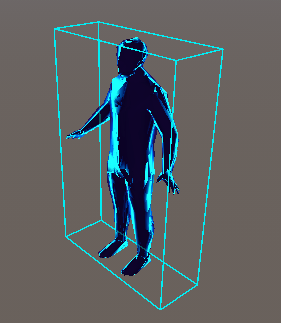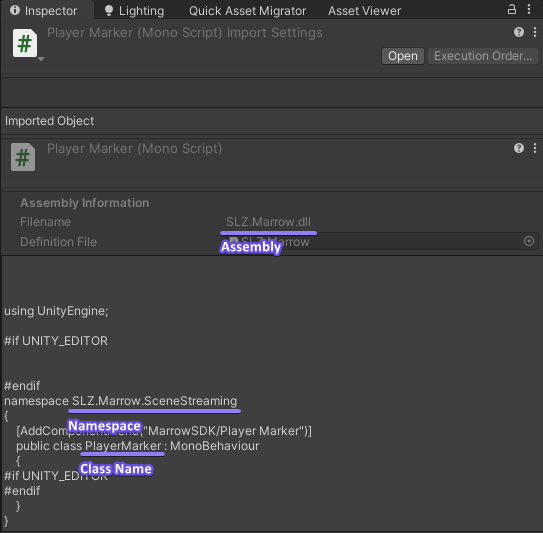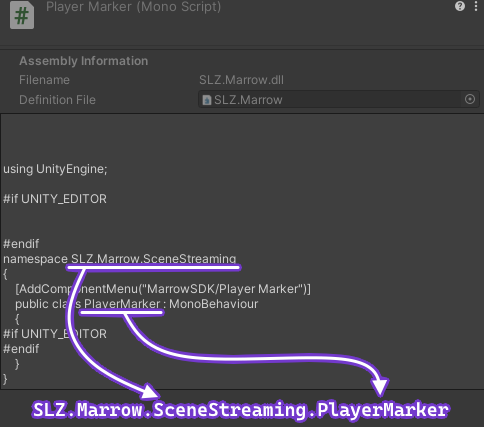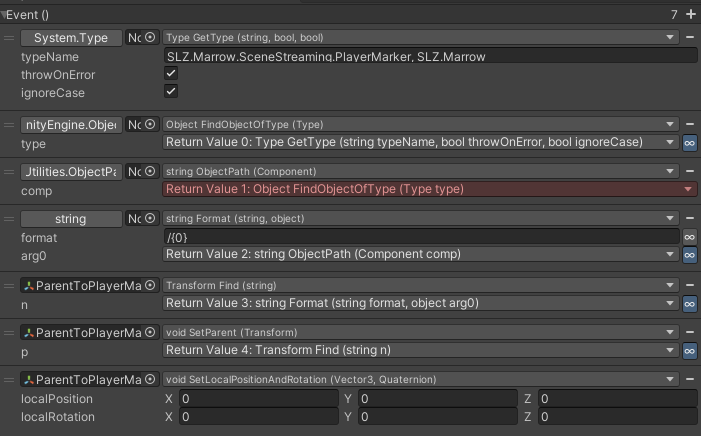This guide covers a lot of ground, so don't feel discouraged if it's too much. You're free to ask for help over in the Bonelab Discord Server, or try out some other guides first while you get your footing. Best of luck!
This guide will cover 3 very useful methods you can use in your logic:
System.Type.GetTypeUnityEngine.Object.FindObjectOfType- used to filter for specific components.SLZ.Marrow.Utilities.ObjectPathExtensions- used to generate a path in the hierarchy, which is covered specifically in the ObjectPathExtensions guide.
About FindObjectOfType
Unity provides us with a method called FindObjectOfType that we can use to search for specific components. In this guide, we’ll use it to locate the PlayerMarker as an example!
That’s this fella if you were wondering - it marks the player’s spawn point.

Getting the Type
Start by making a new UltEventHolder, searching System.Type into the static method type picker and clicking on the GetType override that takes 3 arguments:

I ticked throwOnError so that we get an error in the console if it doesn’t work, and also ticked ignoreCase because case sensitivity is irrelevant.
Now find out what the name of the type we need is. If you have ExtendedSDK installed into your project, we can snatch it from the dummy script. Switch the search to In Packages along the top of your project window, and search PlayerMarker:
Note
Not all ExtendedSDK scripts will be underneath your project’s package cache. If you can’t find the script, try switching the search filter to ‘In Assets’ or ‘All.‘

Great! Click the PlayerMarker script and have a look at it in the inspector.

Start by taking the namespace and class name from the code. Look for namespace in the code and copy the text afterwards. Then look for public class and steal the class name that follows, leaving out anything after the colon.
Also make note of the assembly - we’ll need this in a moment.
Great! Putting the namespace in-front of the class name will give us the full name of your class, which is what we will need in a minute. Combine like so:

Still can't find the class you need?
It may be an engine type, which means it won’t be part of your project.
In this case, classes, namespaces and assemblies can be found on the Unity scripting reference.
Opening a page for any of the class we can find all the info we need.
If we feed the classes full name into the typeName field, and invoke the UltEventHolder, we’ll get an error:


Right now, this function is trying to look for SLZ.Marrow.SceneStreaming.PlayerMarker underneath UltEvents. To fix this, we need to also give it the correct assembly name from earlier.
Simply add a comma and type the assembly name, like so:
SLZ.Marrow.SceneStreaming.PlayerMarker, SLZ.Marrow

Now invoke the UltEventHolder and you’ll see that no errors appear in the console. Sweet!
Using FindObjectOfType
Now that we have the type, we can filter through the scene for an object that matches it.
Add a new action with UnityEngine.Object.FindObjectOfType. We can use our return value from the previous step, and just like that, it’ll find the first component in the scene (in this case our PlayerMarker!)

Add a GameObject with your component on it into the scene so that we can test it in editor. I went ahead and inserted a PlayerMarker into mine.
If we use Debug.Log to output to the console and invoke our UltEvent now, you should see that it successfully found the PlayerMarker in the scene!


Going from Transform to Component
We can use ObjectPathExtensions.ObjectPath to get the Transform that belongs to our component, and then use Transform.SetParent to parent underneath the player marker.

In this case we have a component, so make sure you select the overload that takes in a Component!

Feed the return value from FindObjectOfType into ObjectPath. Since there’s no way to cast Object to Component in UltEvents, you’ll need the to use the Debug menu to do this.
See Using GetComponent with methods that don't take a generic Component (THE RED) for info on exploiting the debug menu for this purpose!

This is perfect! Now that we have an exact path to the player marker, we can feed it into Transform.Find to convert our path into a Transform, then parent underneath it to get the location of the Player Marker.
As described in the ObjectPathExtensions guide, we will use string.Format to add a / to the start of the path. This’ll tell Transform.Find to look underneath the root of the scene, and is very important!
The following example will show the final logic being used to locate a player marker in the scene, parent something underneath it, and then re-center:

In summary:
- Use
GetTypeto Retrieve thePlayerMarkertype. - Use the type to find the first
PlayerMarkercomponent in the scene. - Use ObjectPath to get the path of the
PlayerMarker(example return value:Gameplay/Player Marker). - Use
string.Formatto add a/to the start of our path. - Use
Transform.Findto get ourTransformfrom its path. Adding a/to the front means that we’ll search under the root of the scene, instead of underneath the Transform we provide! - Use
SetParentto re-parent underneath the Player Marker. - Use
SetLocalPositionAndRotationto re-center in the middle of the Player Marker.

